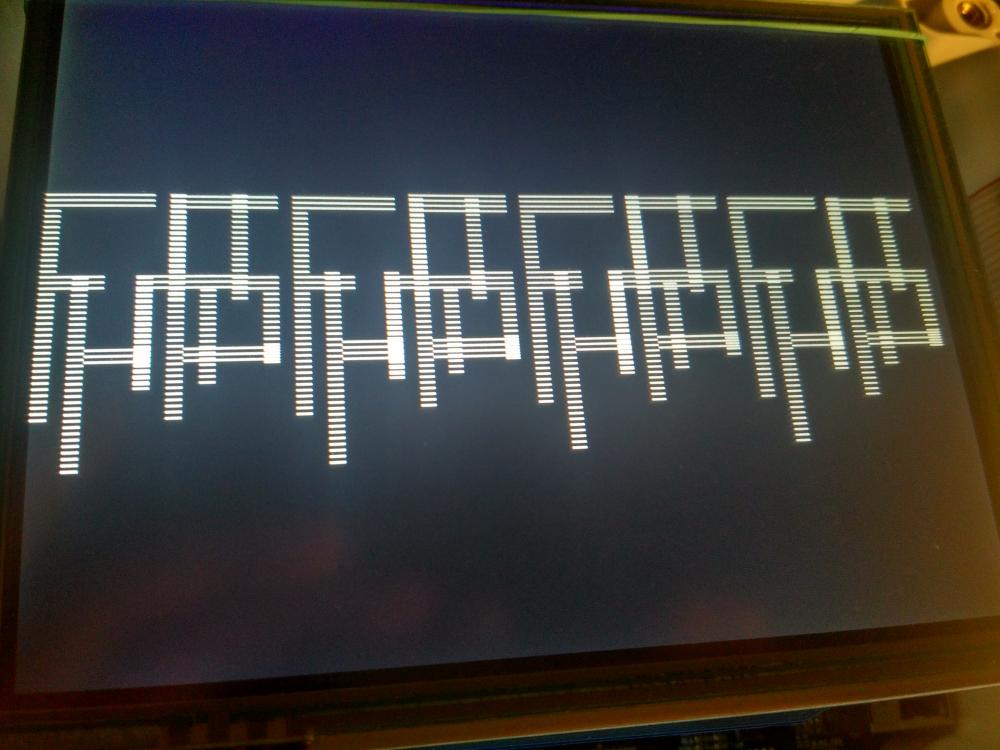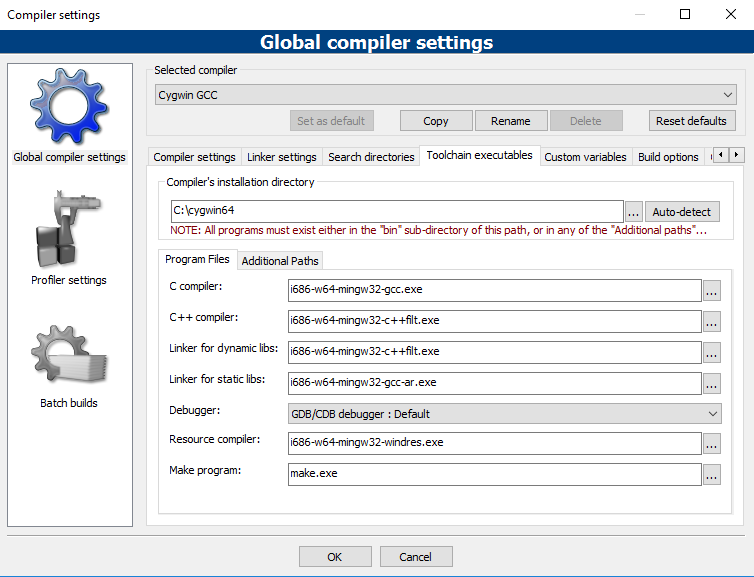
Oshel
Members-
Posts
34 -
Joined
-
Last visited
Recent Profile Visitors
The recent visitors block is disabled and is not being shown to other users.
-
It appears that I get these stripes only if I go from the "button screen" to the "string screen". Both does not have a parent defined. But the 2nd one, when redrawing in gwin_wm.c in _gwinFlushRedraws function enters the while loop: // Do loss of visibility first while ((RedrawPending & DOREDRAW_INVISIBLES)) { ... _GWINwm->vmt->Redraw(gh); ... } and it clears the window with the default color. Honestly I do not have idea why It happens only in one direction and not in the other. Plus I do not see the point of clearing the display (the container area) with default color and then drawing the container with background color.
-
Hello, I would like to ask if this is normal LTDC performance problem- in video when redrawing the screen you can see the black stripes for a moment. 1 per 5 times it does not appear. I am using containers (full screen)- first one is container with 2 buttons, second one is container with a label. I use gwinHide/gwinShow. I don't know if it is problem with memory access or with LTDC settings (default one with ALLOW_2ND_LAYER difned as GFXON). The system is STM32F429 with FreeRTOS. The screen is RGB666 640x480. VID_20180313_214255.mp4
-
http://www.ampdisplay.com/documents/pdf/AM-640480G2TNQW-00H-F.pdf
-
Well, love it. Got line pitch setting set wrongly. Anyway topic to be closed. Have a nice day!
-
Hello oh mighty uGFXians! I've got some problem with DMA2D on a custom hardware with external RAM. I am using LTDC driver in 565 mode. Currently, without DMA2D the intro logo is rendering fine. But after enabling DMA2D I got the image as shown in the picture. The display is natively 666 but I'm using 565. I was expeimenting with 888 as well but with no luck. Any help would be useful couse I gues I am missing something in the settings. I need to show it to the client as a proof of concept to finally buy a licence, huh!
-
I do have the MCU connected to the controller well- I mean D0 to D0, D1 to D1 etc. So when I program the controller in RGB mode it should work. After all- by default it is in RGB. I will look into that.
-
Well, I've changed TFT Panel Data Width to 24 bit and in gdisp_lld_config.h changed to GDISP_PIXELFORMAT_RGB565 to GDISP_PIXELFORMAT_BGR565 and it stated to work ;o Any explaination?
-
Hello, Well, after strugling for few hours I need to ask for a hint. I've just got this display: http://www.buydisplay.com/default/7-tft-screen-touch-lcd-display-module-w-ssd1963-controller-board-mcu I am trying to control it with SMT32F103VC. Everything goes well, it initiates and works (although I had to change PLL values- there is 20 MHz clock onboard instead of 10 MHz). But i do have problem with colors. White is yellow, green is super dark green (almost invisable), yellow is very light green, red is very light green, blue is dark red... I don't get it. I am setting it in RGB565 mode, 16 bit- default ugfx settings. I've also checked if I write good values to the RAM- and yes, everything is fine. EVerything else works, like the backlight etc- it means that ssd accepts commands. Any idea what is wrong? Here is init of FSMC code (works with ssd1289): #define GDISP_REG (*((volatile uint16_t *) 0x60000000)) /* RS = 0 */ #define GDISP_RAM (*((volatile uint16_t *) 0x60020000)) /* RS = 1 */ { GPIO_InitTypeDef GPIO_InitStruct; __HAL_RCC_AFIO_CLK_ENABLE(); __HAL_RCC_GPIOD_CLK_ENABLE(); __HAL_RCC_GPIOE_CLK_ENABLE(); GPIO_InitStruct.Pin = GPIO_PIN_7 | GPIO_PIN_8 | GPIO_PIN_9 | GPIO_PIN_10 | GPIO_PIN_11 | GPIO_PIN_12 | GPIO_PIN_13 | GPIO_PIN_14 | GPIO_PIN_15; GPIO_InitStruct.Speed = GPIO_SPEED_FREQ_HIGH; GPIO_InitStruct.Mode = GPIO_MODE_AF_PP; HAL_GPIO_Init(GPIOE, &GPIO_InitStruct); GPIO_InitStruct.Pin = GPIO_PIN_0 | GPIO_PIN_1 | GPIO_PIN_4 | GPIO_PIN_5 | GPIO_PIN_7 | GPIO_PIN_8 | GPIO_PIN_9 | GPIO_PIN_10 | GPIO_PIN_11 | GPIO_PIN_14 | GPIO_PIN_15; GPIO_InitStruct.Speed = GPIO_SPEED_FREQ_HIGH; GPIO_InitStruct.Mode = GPIO_MODE_AF_PP; HAL_GPIO_Init(GPIOD, &GPIO_InitStruct); __HAL_RCC_FSMC_CLK_ENABLE(); FSMC_NORSRAM_InitTypeDef FSMC_NORSRAM_InitStruct; FSMC_NORSRAM_TimingTypeDef FSMC_NORSRAM_TimingInitStruct; FSMC_NORSRAM_InitStruct.NSBank = FSMC_NORSRAM_BANK1; FSMC_NORSRAM_InitStruct.DataAddressMux = FSMC_DATA_ADDRESS_MUX_DISABLE; FSMC_NORSRAM_InitStruct.MemoryType = FSMC_MEMORY_TYPE_SRAM; FSMC_NORSRAM_InitStruct.MemoryDataWidth = FSMC_NORSRAM_MEM_BUS_WIDTH_16; FSMC_NORSRAM_InitStruct.BurstAccessMode = FSMC_BURST_ACCESS_MODE_DISABLE; FSMC_NORSRAM_InitStruct.WaitSignalPolarity = FSMC_WAIT_SIGNAL_POLARITY_LOW; FSMC_NORSRAM_InitStruct.WrapMode = FSMC_WRAP_MODE_DISABLE; FSMC_NORSRAM_InitStruct.WaitSignalActive = FSMC_WAIT_TIMING_BEFORE_WS; FSMC_NORSRAM_InitStruct.WriteOperation = FSMC_WRITE_OPERATION_ENABLE; FSMC_NORSRAM_InitStruct.WaitSignal = FSMC_WAIT_SIGNAL_DISABLE; FSMC_NORSRAM_InitStruct.AsynchronousWait = FSMC_ASYNCHRONOUS_WAIT_DISABLE; FSMC_NORSRAM_InitStruct.ExtendedMode = FSMC_EXTENDED_MODE_DISABLE; FSMC_NORSRAM_InitStruct.WriteBurst = FSMC_WRITE_BURST_DISABLE; hal_sram.Instance = FSMC_NORSRAM_DEVICE; hal_sram.Extended = FSMC_NORSRAM_EXTENDED_DEVICE; hal_sram.Init = FSMC_NORSRAM_InitStruct; FSMC_NORSRAM_TimingInitStruct.AddressSetupTime = 2; FSMC_NORSRAM_TimingInitStruct.AddressHoldTime = 1; FSMC_NORSRAM_TimingInitStruct.DataSetupTime = 2; FSMC_NORSRAM_TimingInitStruct.BusTurnAroundDuration = 1; FSMC_NORSRAM_TimingInitStruct.CLKDivision = 2; FSMC_NORSRAM_TimingInitStruct.DataLatency = 2; FSMC_NORSRAM_TimingInitStruct.AccessMode = FSMC_ACCESS_MODE_A; HAL_SRAM_Init(&hal_sram, &FSMC_NORSRAM_TimingInitStruct, NULL); __HAL_AFIO_FSMCNADV_DISCONNECTED(); } Here are the settings (got it from the forum here): #define SCREEN_HSYNC_BACK_PORCH 46 #define SCREEN_HSYNC_FRONT_PORCH 210 #define SCREEN_HSYNC_PULSE 8 #define SCREEN_VSYNC_BACK_PORCH 23 #define SCREEN_VSYNC_FRONT_PORCH 22 #define SCREEN_VSYNC_PULSE 8 static const LCD_Parameters DisplayTimings[] = { // You need one of these array elements per display { 800, 480, // Panel width and height SCREEN_HSYNC_BACK_PORCH, SCREEN_HSYNC_FRONT_PORCH, SCREEN_HSYNC_PULSE, // Horizontal Timings (back porch, front porch, pulse) CALC_PERIOD(800,SCREEN_HSYNC_BACK_PORCH,SCREEN_HSYNC_FRONT_PORCH,SCREEN_HSYNC_PULSE), // Total Horizontal Period (calculated from above line) SCREEN_VSYNC_BACK_PORCH, SCREEN_VSYNC_FRONT_PORCH, SCREEN_VSYNC_PULSE, // Vertical Timings (back porch, front porch, pulse) CALC_PERIOD(480,SCREEN_VSYNC_BACK_PORCH,SCREEN_VSYNC_FRONT_PORCH,SCREEN_VSYNC_PULSE), // Total Vertical Period (calculated from above line) CALC_FPR(800,480,SCREEN_HSYNC_BACK_PORCH,SCREEN_HSYNC_FRONT_PORCH,SCREEN_HSYNC_PULSE,SCREEN_VSYNC_BACK_PORCH,SCREEN_VSYNC_FRONT_PORCH,SCREEN_VSYNC_PULSE,60ULL), // FPR - the 60ULL is the frames per second. Note the ULL! FALSE, // Flip horizontally FALSE // Flip vertically }, };
-
Hello, I would like to ask about creation of the custom widget. The widget would consist of buttons which after pressed roll out other buttons/fields to edit. The other buttons (main ones) then would move under the rolled out list. Pictures in order 1-6 shows what I mean (I guess). I would like to ask how to do this? Should I create a custom widget? Or the container with containers? I have a problem with that "Button2" and "Button3" have to go under the list and I don't know where to start to deal with it. I don't want you to give me the solution of course, just a hint how would you do that in a simpliest way. I couldn't paste the pictures ("There was a problem processing the uploaded file. Please contact us for assistance." error) so I paste the link to google drive: https://drive.google.com/file/d/1Wd1oXuc35P5LDGxkud8BcnYdMbj--QCO/view?usp=sharing
-
Well, I figured what have I been doing wrong- I was changing the global compiler setting instead of project settings... I changed the execs as follows (Settings->Compiler->Toolchain executables) on the picture. After that I changed the build options (righ mouse click on project->Build options-> change compiler on cygwin). Last thing is to change the makefile options (right mouse click on project->Properties->This is custom Makefile). And voila! It works! EDIT: Is there a way in CodeBlocks to include ugfx not in makefile but in search directories? I am missing the functions' names complementary. EDIT: Nvm. - I just included "#include "../uGFX/gfx.h" instead of "#include "gfx.h"
-
Hello Joel, I do know about the concept of IDE. Some time ago I was writing the code for SDCC in CodeBlocks and it was working fine. I am only having problems with cygwin this time. I tried to point directories and the same execs but with no effect. Let's wait to see what cpu20 have to say I would be happy to see the working settings
-
Thank you for replies. I am aware that f103 can be too slow for this display. I am trying to build it "from the bottom"- I will try this uC and if it is not fast enough for my client then I will go to F4 or search for other solution with external ram instead of frame buffer inside controller. Currently I am waiting for a display delivery. I was asking about the parallel flash because I assume it would be faster and more efficient than using SPI flash. But the price of the parallel flash is quite high so I gues I will leave this idea.
-
Hello. Sorry for digging out old topic but I do not want to open new one. I followed your guidelines about compiling uGFX projects under Windows. It went smoothly. Now I would like to set up project under latest version of Code::Blocks, but I do have some problems with it. I haven't found any topic or instructions how to do that- I know that you are not Code::Blocks support, but maybe you can write down the instructions so we, users, can have fun with win32 emulator. First of all I have created an empty project in the directory which the "Your First Compile - Windows" tutorial was using. I have created the folder right next to "TestProject". I copied the makefile to that directory. In the codeblocks project I added "main.c" and "gfxconf.h" files from some demo. After that I entered project properties and I picked "This is custom Makefile" box. Next thing I did is changing the compiler: Settings-> Compiler -> Selected Compiler: Cygwin GCC. After that I switched the tab to "Toolchain executables" and I changed the directory to "C:\cygwin64". Aaaand here I have problem. Which compilers from the "bin" directory should I use? How to fill other boxes like "C++ compiler", "Linker for dynamic libs", "Linker for static libs", "Debugger", "Resource compiler" and "Make program"? And should I do some additional steps? Couse I am messing around with these exes files but I still get compiler executables errors. Thank you in advance for a help and happy new 2018 year!
-
Hello, I am currently planning to set up a device that would use STM32F103VC uC and 800 x 480 TFT LCD with SSD1963 (8080). I would like also to add some external flash. The question is, maybe not directly related to uGFX, but is it possible to connect external flash AND the display to FSMC controller? Anyone have done something simillar? I am only asking if it is possible. As far as I know, there is a CS line so there shouldn't be a hardware conflict. Another question is how it would affect the performance of uGFX? Thank you in advance.
-
Hello Joel, Yes, I've disabled all modules that only GOS module is enabled. I am currently working on other stuff but when I have time I will try to know what is going on.


